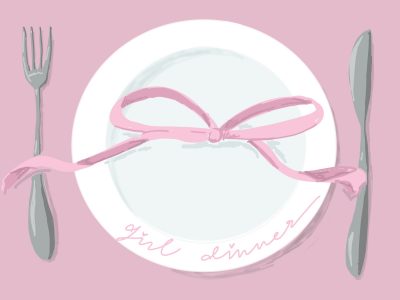If you don’t know the phrase “girl dinner,” you’re either living under a rock, not Gen Z or just don’t have TikTok.

And no, I’m not talking about a snack, a treat, or a meal — I mean it’s just “girl dinner”!
Over the past several months “girl” trends have been emerging on TikTok to display some of the silly and illogical innovations and insights girls have on certain things.
One of the most well known creative facets of this trend is “girl dinner.”
For some girls this is a special dish, for others it’s a random collection of food items, but at its core, girl dinner is really just an elaborate and personally innovative dish that can appease every craving.
Now to clarify, because the trend has taken a few dark twists and turns that imply “girl dinner” only includes low-calorie, low-fat snacks (I’d say meal, but the lack of sustenance does not warrant that title), this trend is not to spotlight habitualized under-eating, but rather highlight a bunch of random food and snack combos that equate to a whole meal.
For instance, when I don’t feel like leaving my dorm, my go-to “girl dinner” is usually pretty creative in terms of options and set up. It normally includes some microwaved edamame, sliced apple with peanut butter, dry cereal, carrots and roasted red pepper hummus, various berries, etc. I mostly opt for a charcuterie board type setup, but the combinations always vary — and a sample of each is a must!
Other variances in what I can go out and scavenge include a “make your own crepe” from the Paris Creperie in Brookline, a HoneyGrow salad or some muesli from Tatte.
Why has the internet decided to call this sensational invention of snack plates “girl dinner”? No one can exactly say, but I know I personally use it to describe foods that I uniquely customize or are my staple favorites.
There’s an interesting sense of bonding around it too. I know that as a picky eater, I’ve found a greater love and variety for foods that my roommates introduce to me as part of their “girl dinner” — take for instance avocado rolls, tofu, savory crepes, miso soup — things I never tried before coming to college, but I now love.
A take similar to “girl dinner” is “girl math” — which has its fair share of appreciation and controversy, too. By one measure, I know a lot of people talk about how things like “girl math” are just a big patriarchal stereotype about how women don’t know how to spend money correctly. But to that I say, it’s merely just an avant-garde approach to personal finance (that some of you just aren’t ready to hear us out on!), especially because women are statistically better investors when it comes to money.
Perhaps the reason we are so good with where we spend our bucks is because of things like “girl math,” which, to me, constitutes a shared universal experience among many women about what they view as profit and loss when it comes to spending and earning money.
I say this because the foundations of “girl math” centers around improving the quality of life through strategic purchasing. For example, I justify spending $57 on my Gisou hair mask once a month because it will make my hair less frizzy and damaged, which means I’ll have to wash it less, which then in turn means I overall spend less money on hair care supplies because I don’t need to buy as much shampoo and conditioner. Boom. “Girl math.”
Now, if you’ve seen Greta Gerwig’s adaptation of “Barbie,” you’ll better understand what I mean when I say that generally speaking, the world of finance caters to men because it was created for men by other men. Remember that scene where Barbie tells Ken all her money is in her savings, to which he replies, “That’s totally wrong. You need treasury bonds, corporate bonds, CDs… CD stands for certificate of deposit.”? Yeah. That’s pretty much the crux of how the world of finance is built on an air of exclusivity that is primarily accessible to men.
Women are already financially disadvantaged when it comes to pay, so I think the function of “girl math” can be a very original take on money and dare I say empowering when you look at it from this standpoint. But at the end of the day, the trend was merely started as a joke to open a discussion about the very inventive ways girls justify and plan their spending.
I, of course, would be remiss to not mention some good ones I have heard from friends — if you don’t buy something, you’ve made a profit. If you pay for something with cash, it’s free. You lose money if you don’t buy something while it’s on sale. If you need to spend an additional $20 to get free shipping, you save money by spending the extra funds. If you put the bill on your card and people Venmo you their share, you made a profit.
My personal mantra is that whatever I buy at City Co. with my dining points is technically free because there’s no deduction on my debit card (even though I pay for those points in my tuition).
No one said “girl math” was perfectly sound financial advice or that “girl dinner” makes a whole lot of sense. But as a funny innovation started by girls FOR girls, take it for what it is: a beautiful, silly and even smart new way of using the media to share some funny thoughts and perspectives.

















































































































Katie • Oct 3, 2023 at 10:15 am
Love this article!